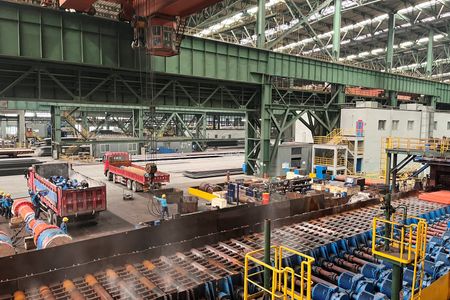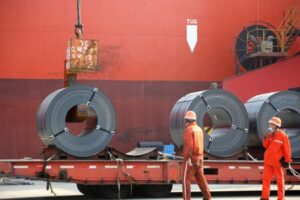BEIJING (Reuters) -China’s June crude steel output rose 1.1% from May and 0.4% from a year earlier, the statistics bureau said on Monday, as mills were encouraged to ramp up production after steel prices rose.
The world’s largest steel producer manufactured 91.11 million metric tons of the ferrous metal last month, data from the National Bureau of Statistics (NBS) showed, higher than 90.12 million metric tons manufactured in May and 90.73 million metric tons in the same month in 2022.
The average daily steel output in June stood around 3.04 million metric tons, up from 2.91 million metric tons in May and higher than 3.02 million metric tons in June 2022, respectively, according to Reuters calculations based on NBS data.
Production from both the blast furnace-based steelmakers and electric arc furnace-based (EAF) steel mills picked up given decent margins, contributing to higher overall output last month, said Pei Hao, a Shanghai-based senior analyst at international brokerage firm FIS.
The blast furnace capacity utilisation rate among the surveyed 247 steelmakers climbed to 92.11% by the end of June from 89.93% in late May, data from consultancy Mysteel showed.
Meanwhile, the capacity utilisation rate among surveyed 34 electric arc furnace steel mills climbed to 42% in late June, up from 37% by the end of May, according to data from Shanghai Metals Market.
China produced 535.64 million metric tons of the ferrous metal in the first half of the year, up 1.3% from the same period last year, NBS data showed.
Some analysts expect steel output to rise in July despite top steelmaking hub Tangshan city requiring mills to cut sintering production by between 30% and 50% this month to improve air quality.
“As prices are expected to begin their recovery in July following these recent efforts to tighten the local market, production will inevitably recover from what are comparatively low levels by Chinese standards,” said Alistair Ramsay, vice president of Rystad Energy Metals.
“We also predict the daily output will move back above 3 million metric tons, meaning a July total over 93 million metric tons, the highest level since March.”
China’s annual steel output may also rise this year for the first time since 2020, Ramsay added.
Unlike the past two years, China’s state planner has so far not announced a cap on annual output to reduce carbon emissions, leaving the market guessing if one will come later than normal this year, or at all.
“There may be no national target; the central government is more wary of any economic policy that isn’t directly supporting GDP this year,” said Tomas Gutierrez, head of data at consultancy Kallanish Commodities.
“There will be pressure to reduce output, and output in the second half of the year will be down from the first half and possibly down on the year too. But that’s not by enough to wipe out the increase in H1,” he added.
(Reporting by Amy Lv and Dominique Patton in Beijing; Editing by Kim Coghill and Jacqueline Wong)





